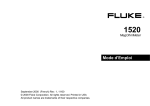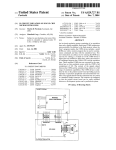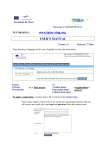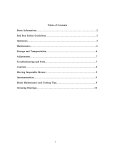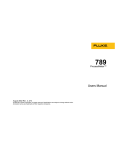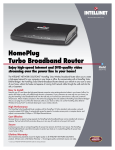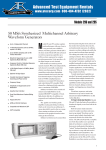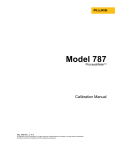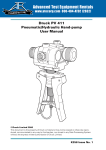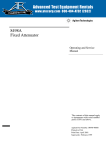Download 1520 - Advanced Test Equipment Rentals
Transcript
® E stablished 1981 Advanced Test Equipment Rentals www.atecorp.com 800-404-ATEC (2832) ® 1520 MegOhmMeter Calibration Manual PN 1592594 November 2000 © 2000 Fluke Corporation, All rights reserved. Printed in USA All product names are trademarks of their respective companies. Limited Warranty & Limitation of Liability Each Fluke product is warranted to be free from defects in material and workmanship under normal use and service. The warranty period is three years and begins on the date of shipment. Parts, product repairs and services are warranted for 90 days. This warranty extends only to the original buyer or end-user customer of a Fluke authorized reseller, and does not apply to fuses, disposable batteries or to any product which, in Fluke’s opinion, has been misused, altered, neglected, contaminated, or damaged by accident or abnormal conditions of operation or handling. Fluke warrants that software will operate substantially in accordance with its functional specifications for 90 days and that it has been properly recorded on non-defective media. Fluke authorized resellers shall extend this warranty on new and unused products to end-user customers only but have no authority to extend a greater or different warranty on behalf of Fluke. Warranty support is available if product is purchased through a Fluke authorized sales outlet or Buyer has paid the applicable international price. Fluke reserves the right to invoice Buyer for importation costs of repair/replacement parts when product purchased in one country is submitted for repair in another country. Fluke’s warranty obligation is limited, at Fluke’s option, to refund of the purchase price, free of charge repair, or replacement of a defective product which is returned to a Fluke authorized service center within the warranty period.To obtain warranty service, contact your nearest Fluke authorized service center to obtain return authorization information, then send the product to that service center, with a description of the difficulty, postage and insurance prepaid (FOB Destination), to the nearest Fluke authorized service center. Fluke assumes no risk for damage in transit. Following warranty repair, the product will be returned to Buyer, transportation prepaid (FOB Destination). If Fluke determines that the failure was caused by neglect, misuse, contamination, alteration, accident or abnormal condition of operation or handling, including overvoltage failures caused by use outside of the product’s specified rating, or normal wear and tear of mechanical components, Fluke will provide an estimate of repair costs and obtain authorization before commencing the work. Following repair, the product will be returned to the Buyer transportation prepaid and the Buyer will be billed for the repair and return transportation charges (FOB Shipping Point). THIS WARRANTY IS BUYER'S SOLE AND EXCLUSIVE REMEDY AND IS IN LIEU OF ALL OTHER WARRANTIES, EXPRESS OR IMPLIED, INCLUDING BUT NOT LIMITED TO ANY IMPLIED WARRANTY OF MERCHANTABILITY OR FITNESS FOR A PARTICULAR PURPOSE. FLUKE SHALL NOT BE LIABLE FOR ANY SPECIAL, INDIRECT, INCIDENTAL OR CONSEQUENTIAL DAMAGES OR LOSSES, INCLUDING LOSS OF DATA, ARISING FROM ANY CAUSE OR THEORY. Since some countries or states do not allow limitation of the term of an implied warranty, or exclusion or limitation of incidental or consequential damages, the limitations and exclusions of this warranty may not apply to every buyer. If any provision of this Warranty is held invalid or unenforceable by a court or other decision-maker of competent jurisdiction, such holding will not affect the validity or enforceability of any other provision. 11/99 Fluke Corporation Fluke Europe B.V. P.O. Box 9090 P.O. Box 1186 Everett, WA 98206-9090 5602 BD Eindhoven U.S.A. The Netherlands Table of Contents Title Page Introduction........................................................................................................ Contacting Fluke................................................................................................ Precautions and Safety Information................................................................... International Symbols.................................................................................... Specifications..................................................................................................... Required Equipment .......................................................................................... Performance Test ............................................................................................... Display Test................................................................................................... Backlight Test................................................................................................ Battery Test ................................................................................................... Discharge Circuit Test ................................................................................... Volts and Ohms Measurement Accuracy Verification.................................. LO Ohms Measurement Accuracy Verification ............................................ Meg Ohm Measurement Accuracy Verification............................................ Meg Ohm Voltage Source Accuracy Verification......................................... Maintaining the Meter........................................................................................ Cleaning......................................................................................................... Replacing and Disposing of the Batteries...................................................... Testing and Replacing the Fuse..................................................................... Replacement Parts and Optional Accessories.................................................... i 1 2 2 2 4 6 7 7 8 8 8 8 9 9 11 12 12 12 13 15 1520 Calibration Manual ii List of Tables Table 1. 2. 3. 4. 5. 6. 7. Title International Symbols ............................................................................................ Required Equipment............................................................................................... Display Icons.......................................................................................................... Volts and Ohms Test .............................................................................................. Lo Ohms Test ......................................................................................................... Meg Ohm Test........................................................................................................ Meg Ohm Voltage Source Test .............................................................................. iii Page 2 6 7 8 9 10 11 1520 Calibration Manual iv List of Figures Figure 1. 2. 3. Title Page Display ................................................................................................................... 7 Replacing the Batteries........................................................................................... 13 Replacing the Fuse ................................................................................................. 14 v 1520 Calibration Manual vi Introduction W Warning To avoid shock or injury, do not perform the verification tests or calibration procedures described in this manual unless you are qualified to do so. The information provided in this document is for the use of qualified personnel only. Caution The 1520 MegOhmMeter contains parts that can be damaged by static discharge. Follow the standard practices for handling static sensitive devices. The information in this manual deals with the Fluke 1520 MegOhmMeter, (hereafter referred to as “the Meter”). Information provided includes: • • • • • Precautions and safety information Specifications Basic maintenance (cleaning, replacing the battery and fuses) Performance test procedures Accessories and replaceable parts For complete operating instructions, refer to the 1520 Users Manual PN 1543203. 1 1520 Calibration Manual Contacting Fluke To order accessories, receive assistance, or locate the nearest Fluke distributor or Service Center, call: USA: 1-888-99-FLUKE (1-888-993-5853) Canada: 1-800-36-FLUKE (1-800-363-5853) Europe: +31 402-678-200 Japan: +81-3-3434-0181 Singapore: +65-738-5655 Anywhere in the world: +1-425-446-5500 Address correspondence to: Fluke Corporation P.O. Box 9090, Everett, WA 98206-9090 USA Fluke Europe B.V. P.O. Box 1186, 5602 BD Eindhoven The Netherlands Visit us on the World Wide Web at: www.fluke.com Precautions and Safety Information WWarning If this product is used in a manner not specified by the manufacturer, the protection provided by the equipment may be impaired. Read the “Safety Information” page before servicing this product. In this manual, a Warning identifies conditions and actions that pose hazard(s) to the user; a Caution identifies conditions and actions that may damage the Meter or the test instruments. International Symbols International symbols used on the Meter and in this manual are explained in Table 1. Table 1. International Symbols Risk of electric shock See manual Equipment protected by double or reinforced insulation J Earth I Fuse D Battery CAT III 2 AC or DC Recycling information Conforms to CSA C22.2 No 1010.1-92 + Amendment 2 1997, UL 3111 and ANSI/ISA SP82.01 1994 VDE Conforms to VDE EN61010 (Pending) Conforms to EU directives t Conforms to UL 3111.1 OVERVOLTAGE (Installation) CATEGORY III, Pollution Degree 2 per IEC1010-1 refers to the level of Impulse Withstand Voltage protection provided. Equipment of OVERVOLTAGE CATEGORY III is equipment in fixed installations (e.g., electricity meter and primary over-current protection equipment. MegOhmMeter Precautions and Safety Information W Safety Information Use of instrument in a manner not specified by the manufacturer may impair safety features/protection provided by the equipment. Read the following safety information carefully before using or servicing the instrument. To avoid electric shock or fire, do the following: • Avoid working alone. • Inspect the test leads for damaged insulation or exposed metal. Check test lead continuity. Damaged leads must be replaced. Do not use the Meter if it looks damaged. • Be careful when working above 30 V ac rms, 42 V ac peak and 60 V dc. Such voltages pose a shock hazard. • When using the probes, keep your fingers away from probe contacts. Keep your fingers behind the finger guards on the probes. • Measurements can be adversely affected by impedances of additional operating circuits connected in parallel or by transient currents. • Verify operation prior to measuring hazardous voltages (voltages above 30 V ac rms, 42 V ac peak and 60 V dc). • Place test leads in proper input terminals. • Disconnect the live test lead before disconnecting the neutral test lead. • Do not use the Meter if the battery indicator (G ) shows a battery empty condition. • Use only Fluke recommended batteries and fuse. • Do not use the Meter with any parts or cover removed. • Do not use the Meter around explosive gas, vapor or dust. • Disconnect the test leads from power sources and from the Meter before changing the batteries or fuse. • Do not use the Meter in a wet environment. • Use only Fluke specified test leads. 3 1520 Calibration Manual Specifications Environmental Operating Temperature -10 °C to +50 °C Storage Temperature -40 °C to +70 °C Temperature Coefficient 0.10 x (specified accuracy)/ °C (< 18 °C or > 28 °C) Relative Humidity: Non condensing (< 10 °C) 90 % RH (10 °C to 30 °C) 75 % RH (30 °C to 40 °C) 45 % RH (40 °C to 50 °C)(Without Condensation) Dust/water resistance IP42 per IEC 529 Operating Altitude 2000 m Storage Altitude 12000 m Mechanical Specifications Size 23,4 x 10 x 6,4 cm (9.2 x 3.9 x 2.5 in) Weight 1 kg (2.2 lbs.) Drop requirement Per IEC 1010-1 Shock and Vibration Conforms to MIL-PREF-28800F class 3 & 4 Safety Specifications Electrical Safety Meets all requirements of EN61010-1, 1995 and EN61557, 1997 Maximum Operating Voltage 600 V ac or dc between any terminal and earth ground Protection Levels CAT ,,,, 600 V, Pollution Degree 2 per EN61010-1 Electromagnetic Compatibility (EMC) Immunity & Emmissions EN 61326-1 (Unspecified for Field strength in excess of 2V/m) ESD EN61000-4-2 Satisfies Criteria B Electrical Specifications 4 Battery C Size 1.5 V alkaline, ANSI/NEDA-14A, IEC-LR14 (4 pieces) Fuse 6 mm x 32 mm (0.25 x 1.25 inch), 0.5 A 660 V, Fast Acting, 50 A Minimum Interrupt rating MegOhmMeter Specifications Insulation Resistance Display Ranges 4.000 MΩ, 40.00 MΩ, 400.0 MΩ, 4000 MΩ Measurement Range (per EN61557-2) 0.250 MΩ to 4000 MΩ Resolution 0.001 MΩ to 10 MΩ Accuracy 2 % + 2 counts 0.250 MΩ to 100.0 MΩ 10 % + 2 counts + 1 %/1000 MΩ 100.0 MΩ to 4000 MΩ Analog Bar Graph 0 to ∞ Test Voltages 250 V, 500 V, 1000 V Accuracy +20 %, -0 % Nominal Current 1 mA Number of measurements 5,000 Circuitry Protection test inhibited if ≥ 30 V ac or dc at inputs Lo Ω Display Range 40.00 Ω Measurement Range 0.10 Ω to 40.00 Ω Accuracy 2 % + 2 counts Resolution 0.01 Ω Analog Bar Graph 0 to 100 Ω Open Circuit Voltage 6 V typical Short Circuit Current 200 mA minimum, (0.2 to 2.0 Ω for >20% battery capacity remaining). Test Leads Zero 2Ω Number of measurements 5,000 Circuitry Protection test inhibited if • 30 V ac or dc at inputs Voltage Range 600 V, dc, 50/60 Hz Resolution 1V Accuracy 2 % + 2 counts Analog Bar Graph 0 to 1000 V Resistance Range 4000 Ω Accuracy 2 % + 2 counts Resolution 1Ω Analog Bar Graph 0 to 10 kΩ Beeper On at ≈30 Ω or less 5 1520 Calibration Manual Required Equipment Required equipment is listed in Table 2. If the recommended models are not available, equipment with equivalent specifications may be used. Repairs or servicing should be performed only by qualified personnel. Caution Do not attempt to use the 5500A or other standard calibrator for insulation and continuity resistance tests. Calibrator damage will result. Table 2. Required Equipment Equipment Calibrator Minimum Required Characteristics AC Voltage Range: 0-600 Vac Accuracy: + 0.5 % Frequency Range: DC – 60 Hz Accuracy: +3 % Recommended Model 9100 w/135 option DC Voltage Range: 0-600 Vdc Accuracy: + 0.5 % Ohms Range: 0 Ω - 4000Ω Accuracy: + 0.5 % Insulation Resistance: 250 kΩ, 500 kΩ, 1 MΩ, 80 MΩ Accuracy: + 0.5% Continuity Resistance: 2 Ohms, 20 Ohms Accuracy: + 0.5% HV Divider DC Voltage Range: 1 kV – 5 kV Fluke 80K-40 Accuracy: + 1% Division Ratio: 1000:1 Input resistance: 1000 MΩ DMM 6 DC Voltage Range: 1 – 1000 Vdc Accuracy: + 0.25% Fluke 87-3 MegOhmMeter Performance Test Performance Test WWarning While performing the following procedures, there are potentially dangerous voltages at the Meter output terminals when the Meter is in the MΩ function. The following performance tests will ensure that the meter is in proper operating condition and meets the published accuracy specifications. If the Meter fails any of the performance test steps, repair is needed. To perform the tests you will need equipment meeting the minimum specification given in Table 2. Display Test While turning the Meter on, push and hold down the beeper button. Compare the display with the example in Figure 1. Check all segments for clarity and contrast. 1 2 3 4 10 5 9 8 7 6 acf12f.eps Figure 1. Display Table 3. Display Icons A Voltage applied to the probes in Insulation Resistance function. B Low Resistance/Resistance function indicator. C Resistance reading held from the last measurement in Insulation Resistance or Low Resistance function. D Beeper symbol shows if beeper function is turned on in Resistance function. E Zero symbol is on if test leads are zeroed out. F Main reading display for all functions. G Analog bar graph displays resistance on a logarithmic scale and voltage on a linear scale. The value always tracks the main reading. H High voltage warning symbol flashes if voltage ≥ 30 V ac or dc is present on the probes. I Battery life indicator. Displays briefly when the Meter is first switched to a function. Displays the amount of battery voltage left in increments of 25 %. J Lock symbol is on if the TEST mode is locked in Insulation or Low Resistance functions. 7 1520 Calibration Manual Backlight Test Push the backlight button and note that the all three backlight LEDs come on. Each LED can be seen on the left side of the display as an intensified area. Battery Test Turn the Rotary Switch to the Battery Check position and note that the batteries have 90% or better charge. Replace if necessary. Refer to "User Maintenance" for detailed instructions on changing the batteries. Discharge Circuit Test The following Discharge Circuit Test is a safety related test that verifies input jack wiring to the PCA, the RSOB contacts, RSOB pads on the PCA, and other active components on the PCA. Caution DO NOT push the Meter TEST button during the following procedure. 1. Connect the DMM to the VΩ and COM jack of the Meter. 2. Set the DMM to kΩ function. 3. Turn the Meter Rotary Switch to the 250V, 500V, 1000V and Lo Ω position. Check that the DMM reading for each position is between 1600 and 2600 Ω. Volts and Ohms Measurement Accuracy Verification To verify accuracy of the V and Ω function, complete the following: Perform the battery test and replace as necessary 1. Connect the Calibrator to the VΩ and COM inputs on the Meter. 2. Turn the Meter Rotary Switch to the function listed for each step of Table 4. 3. Apply the input for the steps 1 through 10 as listed in Table 4. 4. Compare the Meter displayed reading with the display limits of Table 4. 5. DISCONNECT THE CALIBRATOR FROM THE METER. Table 4. Volts and Ohms Test Display Reading Step 8 Function Source Output Lower Limit Upper Limit 1 Volts 0 Volts -2 2 2 Volts 180 V 174 186 3 Volts 540 V 527 553 4 Volts 180 V @ 60 Hz 174 186 5 Volts 540 V @ 60 Hz 527 553 6 Ω 0Ω 0 2 7 Ω 1200 Ω (UTTi High) 1174 1226 8 Ω 3600 Ω (UUTi High) 3526 3674 9 Ω Open >4000 >4000 10 Continuity on 27 Ω Beeper on Beeper on MegOhmMeter Performance Test LO Ohms Measurement Accuracy Verification Caution During the following tests, the 9100 source output must be applied to the UUT prior to pushing the UUT TEST button. Failure to do this WILL damage the 9100. Do not attempt to use the 5500A or other standard calibrator for the following test. Calibrator Damage will result. Use the calibrator continuity resistance function to verify accuracy of the LO Ω function as follows: 1. Turn the Meter Rotary Switch to LO Ω. 2. Connect the calibrator to the Meter VΩ and COM input terminals using 4 wire test leads. 3. Apply zero ohms from the calibrator. 4. Zero the LO ohms function (press and release the TEST button and then press and hold the ZERO button until the Meter beeps). 5. Apply the Calibrator Output values listed in Table 5 and compare the Meter reading with the display reading limits given. Table 5. Lo Ohms Test Display Reading Limits Step Function Calibrator Output Lower Limit Upper Limit 1 LO Ohms 2 Ohms 1.94 2.06 2 LO Ohms 20 Ohms 19.58 20.42 Meg Ohm Measurement Accuracy Verification Use the calibrator Insulation Resistance function to verify MΩ measurement accuracy as follows: Caution During the following tests the 9100 source output must be applied to the UUT prior to pushing the UUT TEST button. Failure to do this WILL damage the 9100. Do not attempt to use the 5500A or other standard calibrator for the following test. Calibrator Damage will result. 9 1520 Calibration Manual WWarning Pushing the TEST button produces a potentially dangerous voltage, at the Meter output terminals, when the Meter is in the MΩ function. 1. Turn the Meter Rotary Switch to the MΩ function and set the Meter range as listed in Table 6. 2. Apply the calibrator output values listed in step 1 of Table 6. 3. Press and hold the Meter TEST button until the Meter display reading settles to its final value. 4. Compare the Meter displayed reading with the display reading limits of Table 6. 5. Release the TEST button. 6. Repeat the above process for all remaining steps in Table 6. Table 6. Meg Ohm Test Display Reading Step 10 Function Range Calibrator Output Lower Limit Upper Limit 1 MΩ 250 V 250 kΩ 243 257 2 MΩ 500 V 250 kΩ 243 257 3 MΩ 1000 V 250 kΩ 243 257 4 MΩ 250 V 500 kΩ 488 512 5 MΩ 500 V 500 kΩ 488 512 6 MΩ 1000 V 500 kΩ 488 512 7 MΩ 250 V 1 MΩ 0.978 1.022 8 MΩ 500 V 1 MΩ 0.978 1.022 9 MΩ 1000 V 1 MΩ 0.978 1.022 10 MΩ 250 V 80 MΩ 78.2 81.8 11 MΩ 500 V 80 MΩ 78.2 81.8 12 MΩ 1000 V 80 MΩ 78.2 81.8 13 MΩ 250 V Open >1000 >1000 14 MΩ 500 V Open >2000 >2000 15 MΩ 1000 V Open >4000 >4000 MegOhmMeter Performance Test Meg Ohm Voltage Source Accuracy Verification To verify MΩ Voltage Source Accuracy complete the following procedure: WWarning Pushing the TEST button produces a potentially dangerous voltage, at the Meter output terminals, when the Meter is in the MΩ function. 1. Connect the DMM, listed in Table 2, to the Meter VΩ and COM input terminals. Set the DMM to the VDC function. 2. Turn the Meter Rotary Switch to the MΩ function and range listed in Table 7, step 1. 3. Press and hold the TEST button until the Meter reading settles to its final value. 4. Compare the DMM reading with the display reading limits of Table 7. 5. Release the TEST button. 6. Repeat the above process for Table 7, Step 2. 7. Disconnect the DMM from the Meter and connect the HV Divider to the DMM. 8. Connect the DMM, with HV Divider, to the Meter VΩ and COM input terminals. 9. Press and hold the TEST button until the Meter reading settles to its final value. 10. Compare the DMM display reading with the display reading limits of Table 7, step 3. Table 7. Meg Ohm Voltage Source Test Display Reading Step Function Range Measurement Device Lower Limit Upper Limit 1 MΩ 250 V Test DMM 250 300 2 MΩ 500 V Test DMM 500 600 3 MΩ 1000 V Test DMM with HV Divider 1.000 1.200 11 1520 Calibration Manual Maintaining the Meter This section provides basic maintenance information, including fuse and battery replacement instructions. Caution Do not attempt to repair or service your Meter unless you are qualified to do so and have the relevant calibration, performance test, and service information. Cleaning Clean only with soap and water. Remove any residue afterwards. Periodically wipe the case with a damp cloth and mild detergent. Do not use abrasives or solvents. Replacing and Disposing of the Batteries W Warning To avoid electric shock, disconnect the test leads from the inputs before opening the Meter for battery replacement. To avoid false readings, which could lead to possible electric shock or personal injury, replace the batteries as soon as the battery empty indicator G appears. Note This Meter contains alkaline batteries. Do not dispose of these batteries with other solid waste. Used batteries should be disposed of by a qualified recycler or hazardous materials handler. Contact your authorized Fluke Service center for recycling information. The Meter uses four alkaline C cell batteries (supplied). To replace the batteries, do the following (see Figure 2): 1. Turn the rotary switch to the OFF position. 2. Disconnect test leads from any power source. 3. Remove the holster. 4. Place the Meter face down on a nonabrasive surface and loosen the two screws with a flat-blade screwdriver. 5. Lift the battery access lid away from the Meter. 6. Replace the C cells as shown in Figure 2. Observe the battery polarity shown in the battery compartment. 7. Secure the battery access lid back in position with the two screws. 12 MegOhmMeter Maintaining the Meter acf10f.eps Figure 2. Replacing the Batteries Testing and Replacing the Fuse W Warning To avoid electric shock, disconnect the test leads from the inputs before opening the Meter for fuse replacement. To prevent personal injury or damage to the Meter, install ONLY the Fluke specified fuse identified in the “Replacement Parts and Optional Accessories” section. Before replacing the fuse, test it as described in the next section. Testing the Fuse Use the following procedure to test the internal fuse of the Meter. 1. Turn the rotary switch to the Lo Ω Function. 2. Connect the test leads to the input terminals and short them together. Press TEST. 3. The display should indicate approximately 0.5 Ω. If the display reads >40 Ω, replace the fuse as described next and test again. 13 1520 Calibration Manual Replacing the Fuse W Warning To avoid electric shock, personal injury or damage to the Meter, use ONLY the specified fuse, and in accordance with the following procedure. If the previous fuse test indicates that the fuse is defective (resistance > 40 Ω), replace the fuse as follows: 1. Turn the rotary switch to the OFF position. 2. Disconnect test leads from any power source. 3. Follow Steps 3 - 5 to remove the battery access lid as described under "Replacing and Disposing of the Batteries". 4. Unscrew the bottom cover as shown in Figure 3. 5. Remove the fuse as shown in Figure 3. 6. Replace with a new fuse. 7. Place the bottom cover on and secure the screws. 8. Insert the batteries. Observe the battery polarity shown in the battery compartment. 9. Secure the battery access lid. 10. Test the fuse as described under "Testing the Fuse". acf11f.eps Figure 3. Replacing the Fuse 14 MegOhmMeter Replacement Parts and Optional Accessories Replacement Parts and Optional Accessories Replacement Part Part Number Battery 1.5 V Alkaline Size C 423582 Test Lead set 669058 Test Probe, 1 kV, lantern tip, red 803459 Test Probe, 1 kV, lantern tip, black 803467 Alligator Clip, red 803434 Alligator Clip, black 803442 Carrying Case 603115 Holster 670643 Hand Strap 669069 Fuse,0.5A,750VAC,Fast Acting,0.25X1.25,Glass Tube 1556096 Battery Spring 936906 Screw 942946 Shock Absorber 948708 Battery Cover (Overmolded) 1274679 Hook, (Pad Transfer) 1270801 User Manual, Multi-Language 1543203 CD Rom (containing Fluke Users Manual) 1558934 Optional Accessories Part Number Harness 669074 Tool Pack 669903 15 1520 Calibration Manual 16

























